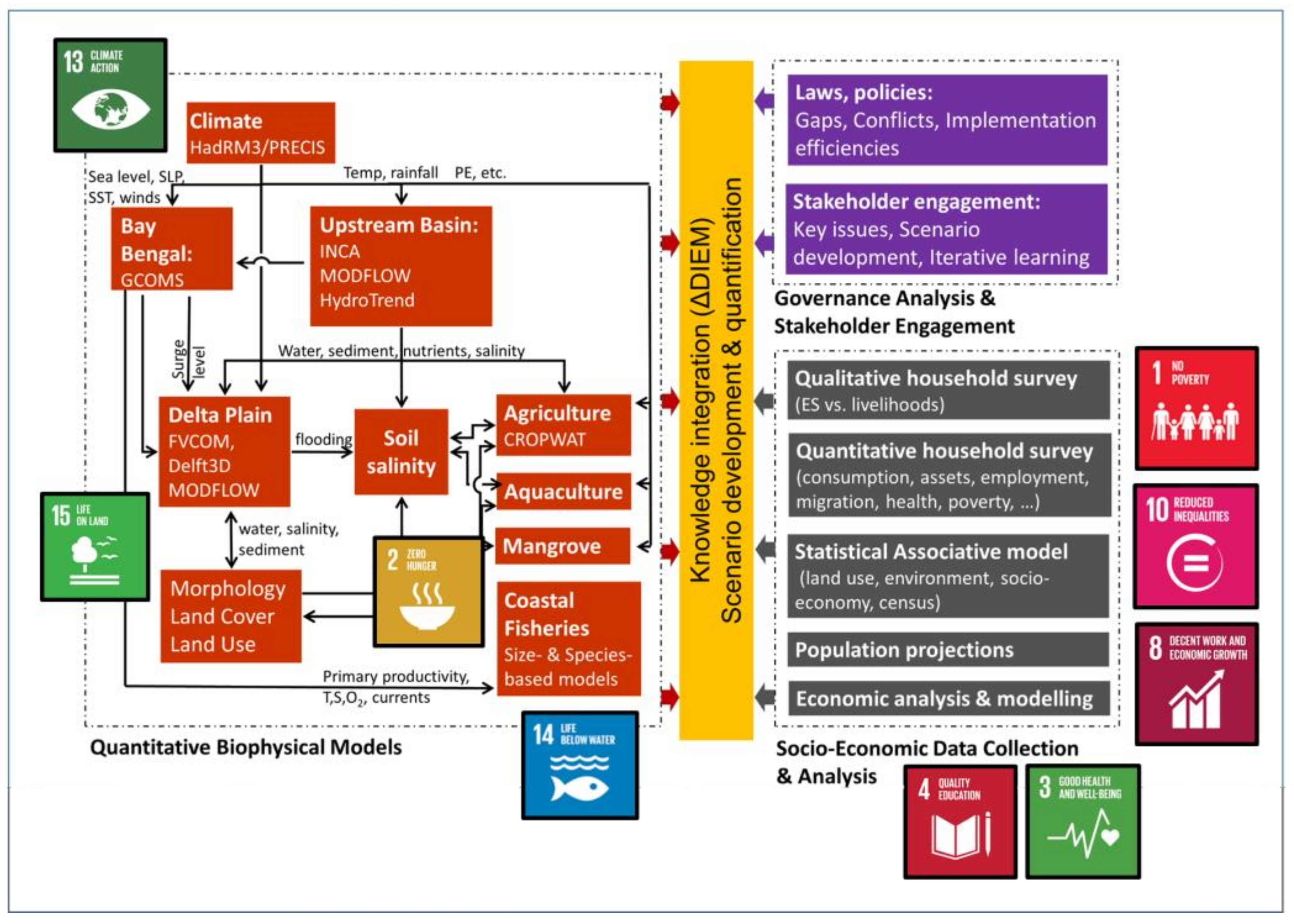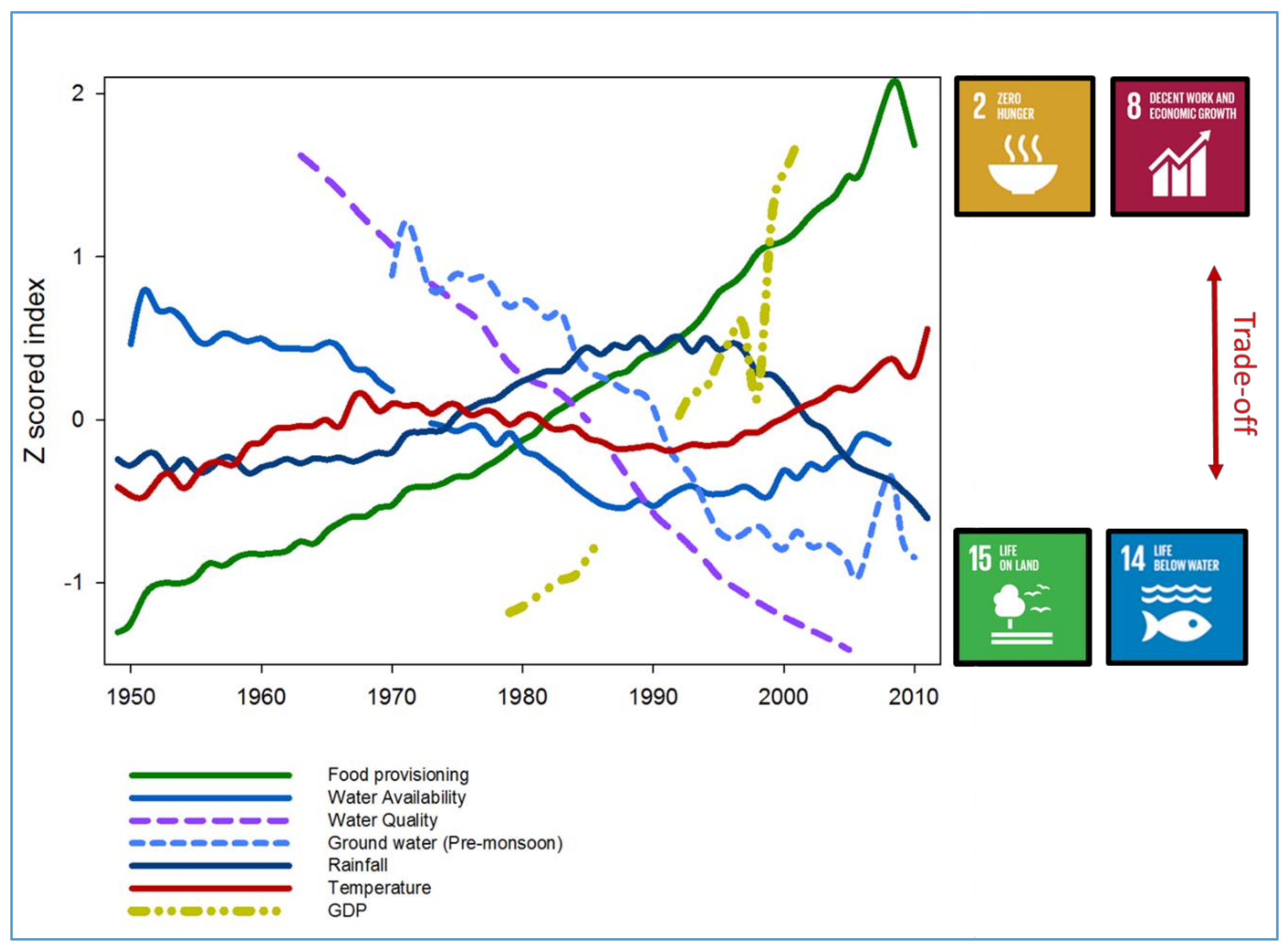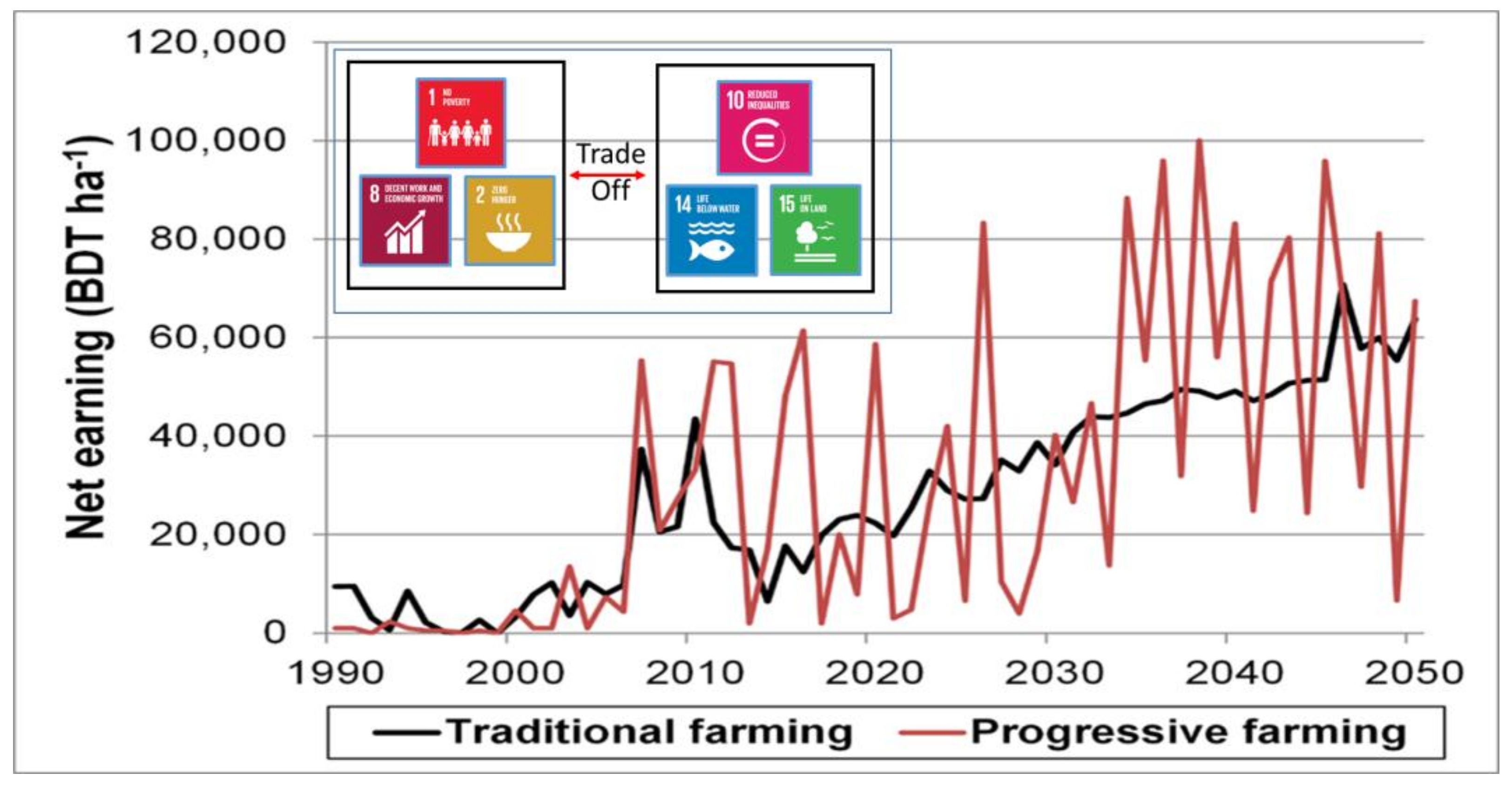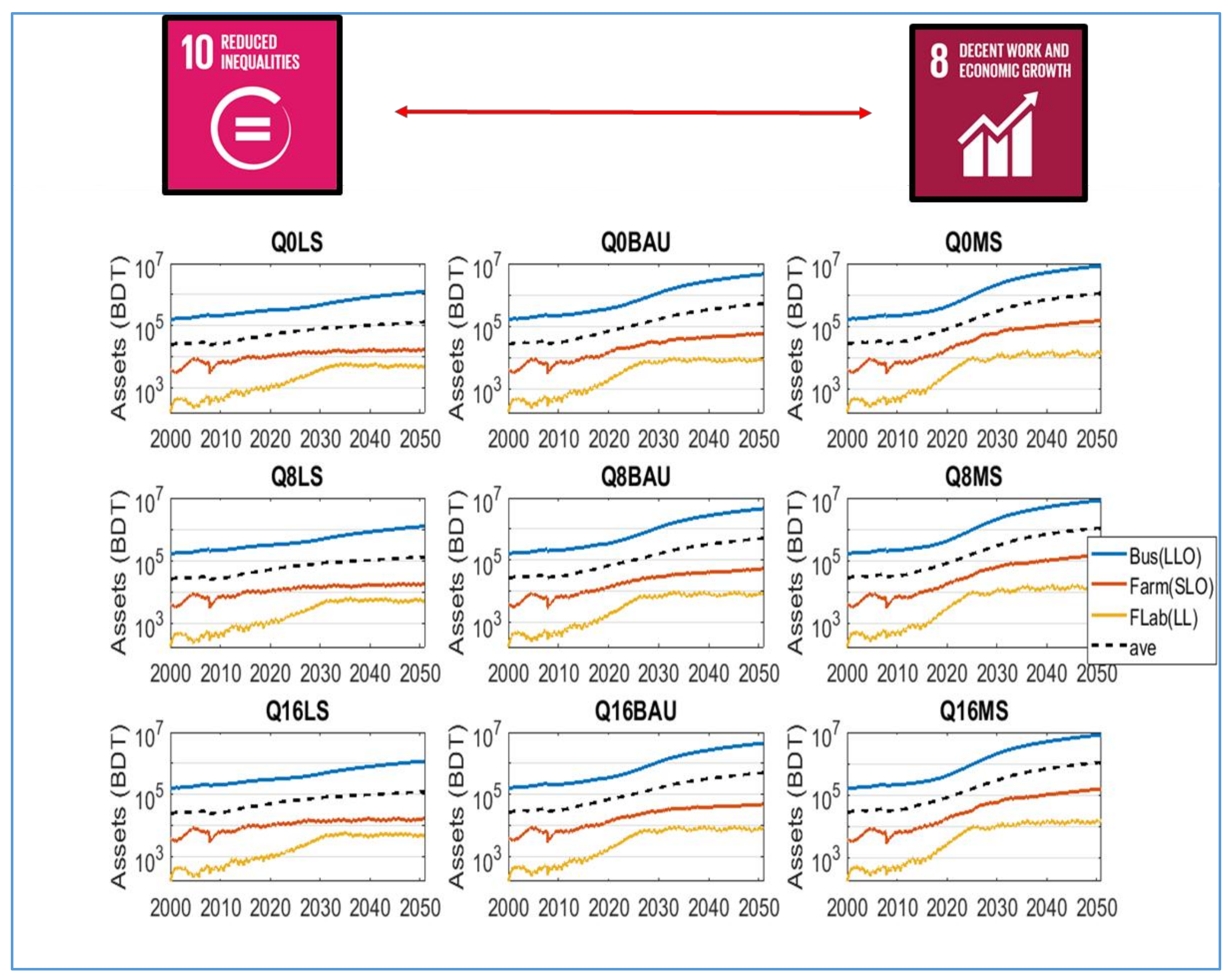Potential Trade-Offs between the Sustainable Development Goals in Coastal Bangladesh
Abstract
:1. Introduction
2. Materials and Methods
3. Results: Case Studies of Potential Trade-Offs between the SDGs in Coastal Bangladesh
3.1. Case Study 1: Historical Economic Growth and Environmental Pressure on Resources
3.2. Case Study 2: Trade-Offs between Progressive and Traditional Farming
3.3. Case Study 3: Trade-Offs between Economic Development and Equity
4. Discussion
5. Conclusions
Acknowledgments
Author Contributions
Conflicts of Interest
References
- UN General Assembly. Seventieth Session Agenda Items 15 and 116 Resolution Adopted by the General Assembly on 25 September 2015. Transforming Our World: The 2030 Agenda for Sustainable Development; UN General Assembly: New York, NY, USA, 2015. [Google Scholar]
- Keitsch, M. Structuring Ethical Interpretations of the Sustainable Development Goals—Concepts, Implications and Progress. Sustainability 2018, 10, 829. [Google Scholar] [CrossRef]
- Vasconcellos Oliveira, R. Back to the Future: The Potential of Intergenerational Justice for the Achievement of the Sustainable Development Goals. Sustainability 2018, 10, 427. [Google Scholar] [CrossRef]
- Le Blanc, D. Towards Integration at Last? The Sustainable Development Goals as a Network of Targets. Sustain. Dev. 2015, 23, 176–187. [Google Scholar]
- Hausman, D.M.; McPherson, M.S. Taking ethics seriously: Economics and contemporary moral philosophy. J. Econ. Lit. 1993, 31, 671–731. [Google Scholar]
- Van Egmond, N.D.; De Vries, H.J.M. Sustainability: The search for the integral worldview. Futures 2011, 43, 853–867. [Google Scholar] [CrossRef]
- Machingura, F.; Lally, S. The Sustainable Development Goals and Their Trade-Offs. ODI Development Progress, Case Study Report. 2017. Available online: https://www.odi.org/publications/10726-sustainable-development-goals-and-their-trade-offs (accessed on 15 March 2018).
- Stewart, F. The sustainable development goals: A comment. J. Glob. Ethics 2015, 11, 288–293. [Google Scholar] [CrossRef]
- Stafford-Smith, M.; Griggs, D.; Gaffney, O.; Ullah, F.; Reyers, B.; Kanie, N.; Stigson, B.; Shrivastava, P.; Leach, M.; O’Connell, D. Integration: The key to implementing the Sustainable Development Goals. Sustain. Sci. 2017, 12, 911–919. [Google Scholar] [CrossRef]
- Nilsson, M.; Griggs, D.; Visbeck, M. Map the interactions between sustainable development goals: Present a simple way of rating relationships between the targets to highlight priorities for integrated policy. Nature 2016, 534. [Google Scholar] [CrossRef]
- Bowen, K.J.; Cradock-Henry, N.A.; Koch, F.; Patterson, J.; Häyhä, T.; Vogt, J.; Barbi, F. Implementing the “Sustainable Development Goals”: Towards addressing three key governance challenges—Collective action, trade-offs, and accountability. Curr. Opin. Environ. Sustain. 2017, 26–27, 90–96. [Google Scholar] [CrossRef]
- Gupta, J.; Vegelin, C. Sustainable development goals and inclusive development. Int. Environ. Agreem. 2016, 16, 433. [Google Scholar] [CrossRef]
- Lorek, S.; Spangenberg, J.H. Sustainable consumption within a sustainable economy: Beyond green growth and green economies. J. Clean. Prod. 2014, 62, 33–44. [Google Scholar] [CrossRef]
- Scheffer, M.; Bascompte, J.; Brock, W.A.; Brovkin, V.; Carpenter, S.R.; Dakos, V.; Held, H.; van Nes, E.H.; Rietkerk, M.; Sugihara, G. Early-warning signals for critical transitions. Nature 2009, 461, 53–59. [Google Scholar] [CrossRef] [PubMed]
- Schluter, M.; Mcallister, R.; Arlinghaus, R.; Bunnefeld, N.; Eisenack, K.; Holker, F.; Milner-Gulland, E.; Muller, B.; Nicholson, E.; Quaas, M.; et al. New Horizon for Managing the Environment: A Review of Couples Social-Ecolological Systems Modeling. Nat. Resour. Model. 2012, 25, 219–272. [Google Scholar] [CrossRef]
- Nicholls, R.J.; Hutton, C.W.; Lázár, A.N.; Allan, A.; Adger, W.N.; Adams, H.; Wolff, J.; Rahman, M.; Salehin, M. Integrated assessment of social and environmental sustainability dynamics in the Ganges-Brahmaputra-Meghna delta, Bangladesh. Estuar. Coast. Shelf Sci. 2016, 1–12. [Google Scholar] [CrossRef]
- Nicholls, R.J.; Hutton, C.W.; Adger, W.N.; Hanson, S.E.; Rahman, M.M.; Salehin, M. Integrative Analysis for the Ganges-Brahmaputra-Meghna Delta in Bangladesh; Palgrave: London, UK, 2018; in press. [Google Scholar]
- Woodroffe, C.N.; Nicholls, R.J.; Saito, Y.; Chen, Z.; Goodbred, S.L. Chapter 10: Landscape Variability and the Response of Asian Megadeltas to Environmental Change. In Global Change and Integrated Coastal Management; Harvey, N., Ed.; Springer: New York, NY, USA, 2006. [Google Scholar]
- Szabo, S.; Hajra, R.; Baschieri, A.; Matthews, Z. Inequalities in Human Wellbeing in the Urban Ganges-Brahmaputra Delta: Implications for Sustainable Development; Working Paper 67; ESRC Centre for Population Change: Southampton, UK, 2015. [Google Scholar]
- UN General Assembly. United Nations General Assembly Draft Outcome Document of the United Nations Summit for the Adoption of the Post-2015 Development Agenda; UN General Assembly: New York, NY, USA, 2015. [Google Scholar]
- Adams, H.; Adger, W.N.; Huq, H.; Rahman, R.; Salehin, M. Transformations in land use in the southwest coastal zone of Bangladesh: Resilience and reversibility under environmental change. Proceedings of Transformation in a Changing Climate International Conference, Oslo, Norway, 19–21 June 2013. [Google Scholar]
- Gain, A.K.; Giupponi, C. Impact of the Farakka Dam on thresholds of the hydrologic flow regime in the Lower Ganges River Basin (Bangladesh). Water 2014, 6, 2501–2518. [Google Scholar] [CrossRef] [Green Version]
- Mahmuduzzaman, M.; Ahmed, Z.U.; Nuruzzaman, A.K.M.; Ahmed, F.R.S. Causes of salinity intrusion in coastal belt of Bangladesh. Int. J. Plant Res. 2014, 4, 8–13. [Google Scholar]
- Amoako Johnson, F.; Hutton, C.W.; Hornby, D. Is shrimp farming a successful adaptation to salinity intrusion? A geospatial associative analysis of poverty in the populous Ganges–Brahmaputra–Meghna Delta of Bangladesh. Sustain. Sci. 2016, 11, 423. [Google Scholar] [CrossRef]
- Whitehead, P.G.; Barbour, E.; Futter, M.N.; Sarkar, S.; Rodda, H.; Caesar, J.; Butterfield, D.; Jin, L.; Sinha, R.; Nicholls, R.; et al. Impacts of climate change and socio-economic scenarios on flow and water quality of the Ganges, Brahmaputra and Meghna (GBM) river systems: Low flow and flood statistics. Environ. Sci. Process. Impacts 2015, 17, 1057–1069. [Google Scholar] [CrossRef] [PubMed]
- Chapman, A.; Darby, S. Evaluating sustainable adaptation strategies for vulnerable mega-deltas using system dynamics modelling: Rice agriculture in the Mekong Delta’s An Giang Province, Vietnam. Sci. Total Environ. 2016, 559, 326–338. [Google Scholar] [CrossRef] [PubMed]
- Gies, L.; Agusdinata, D.B.; Merwade, V. Drought adaptation policy development and assessment in East Africa using hydrologic and system dynamics modeling. Nat. Hazards 2014, 74, 789–813. [Google Scholar] [CrossRef]
- Wang, X.-J.; Zhang, J.-Y.; Shahid, S.; He, R.-M.; Xia, X.-H.; Mou, X.-L. Potential impact of climate change on future water demand in Yulin city, Northwest China. Mitig. Adapt. Strateg. Glob. Chang. 2015, 20, 1–19. [Google Scholar]
- Allan, A.; Barbour, E. Integrating Science, Modelling and Stakeholders through Qualitative and Quantitative Scenarios. Working Paper #5 February 2015. ESPA Deltas. Available online: http://www.espadelta.net/resources/docs/working_papers/scenarios_working_paper_v8.pdf (accessed on 12 March 2018).
- Lazar, A.N.; Clarke, D.; Adams, H.; Akanda, A.R.; Szabo, S.; Nicholls, R.J.; Matthews, Z.; Begum, D.; Saleh, A.F.M.; Abedin, A.; et al. Agricultural livelihoods in coastal Bangladesh under climate and environmental change—A model framework. Environ. Sci. Process. Impacts 2015, 1–14. [Google Scholar] [CrossRef]
- Adams, H.; Adger, W.N.; Ahmad, S.; Ahmed, A.; Begum, D.; Matthews, Z.; Rahman, M.M.; Streatfield, P.K. Spatial and Temporal Dynamics of Multidimensional Well-Being, Livelihoods and Ecosystem Services in Coastal Bangladesh; UK Data Archive: Colchester, UK, 2016. [Google Scholar]
- Lázár, A.N.; Payo, A.; Adams, H.; Ahmed, A.; Allan, A.; Akanda, A.R.; Johnson, F.A.; Barbour, E.J.; Biswas, S.; Caesar, J.; et al. Integrative Analysis Applying the Delta Dynamic Integrated Emulator Model in South-West Coastal Bangladesh. In Ecosystem Services for Well-Being in Deltas: Integrated Assessment for Policy Analysis; Palgrave: London, UK, 2018; accepted. [Google Scholar]
- Lázár, A.N.; Adams, H.; Adger, N.; Nicholls, J.R. Modelling short and long term impacts of seasonal diversification on household wellbeing and poverty trajectories. Earth’s Future, under review.
- MathWorks. MATLAB and Statistics Toolbox Release 2017; The MathWorks, Inc.: Natick, MA, USA, 2017. [Google Scholar]
- BBS. Report of the Household Income & Expenditure Survey 2010, Bangladesh Bureau of Statistics, Statistical Division, Ministry of Planning; BBS: Dhaka, Bangladesh, 2011. [Google Scholar]
- Bangladesh Delta Plan 2100, Government of Bangladesh. in press. Available online: https://www.bangladeshdeltaplan2100.org/ (accessed on 2 March 2018).
- Hossain, M.S.; Dearing, J.A.; Rahman, M.M.; Salehin, M. Recent changes in ecosystem services and human well-being in the Bangladesh coastal zone. Reg. Environ. Chang. 2016, 16, 429. [Google Scholar] [CrossRef]
- Alam, E.; Dominey-Howes, D. A new catalogue of tropical cyclones of the northern Bay of Bengal and the distribution and effects of selected landfalling events in Bangladesh. Int. J. Climatol. 2015, 35, 801–835. [Google Scholar] [CrossRef]
- Lumbroso, D.; Suckall, N.; Nicholls, R.; White, K. Enhancing resilience to coastal flooding from severe storms in the USA: International lessons. Nat. Hazards Earth Syst. Sci. 2017, 17, 1357–1373. [Google Scholar] [CrossRef]
- Dearing, J.A.; Yang, X.; Dong, X.; Zhang, E.; Chen, X.; Langdon, P.G.; Zhang, K.; Zhang, W.; Dawson, T.P. Extending the timescale and range of ecosystem services through paleoenvironmental analyses, exemplified in the lower Yangtze basin. Proc. Natl. Acad. Sci. USA 2012, 109, E1111–E1120. [Google Scholar] [CrossRef] [PubMed]
- Caesar, J.; Janes, T.; Lindsay, A.; Bhaskaran, B. Temperature and precipitation projections over Bangladesh and the upstream Ganges, Brahmaputra and Meghna systems. Environ. Sci. Process. Impacts 2015, 17, 1047–1056. [Google Scholar] [CrossRef] [PubMed]
- McShane, T.O.; Hirsch, P.D.; Trung, T.C.; Songorwa, A.N.; Kinzig, A.; Monteferri, B.; Mutekanga, D.; Van Thang, H.; Dammert, J.L.; Pulgar-Vidal, M.; et al. Hard choices: Making trade-offs between biodiversity conservation and human well-being. Biol. Conserv. 2011, 144, 966–972. [Google Scholar] [CrossRef]
- Alkire, S.; Seth, S. Multidimensional poverty reduction in India between 1999 and 2006: Where and how? World Dev. 2015, 72, 93–108. [Google Scholar] [CrossRef]
- Griggs, D.; Stafford Smith, M.; Rockström, J.; Öhman, M.C.; Gaffney, O.; Glaser, G.; Kanie, N.; Noble, I.; Steffen, W.; Shyamsundar, P. An integrated framework for sustainable development goals. Ecol. Soc. 2014, 19, 49. [Google Scholar] [CrossRef]
- Hirsch, P.D.; Adams, W.M.; Brosius, J.P.; Zia, A.; Bariola, N.; Dammert, J.L. Acknowledging conservation trade-offs and embracing complexity. Conserv. Biol. 2011, 25, 259–264. [Google Scholar] [CrossRef] [PubMed]
- De Vries, B.J.; Petersen, A.C. Conceptualizing sustainable development: An assessment methodology connecting values, knowledge, worldviews and scenarios. Ecol. Econ. 2009, 68, 1006–1019. [Google Scholar] [CrossRef]





| SDG 1. | No poverty | Eradicating poverty in all its forms by 2030. |
| SDG 2. | No hunger | End all forms of hunger and malnutrition by 2030. |
| SDG 8. | Decent work and economic growth | The SDGs promote sustained economic growth and higher levels of productivity. |
| SDG 10. | Reduced inequalities | Reduce inequality within and among countries. |
| SDG 14. | Life below water | To sustainably manage and protect marine and coastal ecosystems. |
| SDG 15. | Life on land | To conserve and restore the use of terrestrial ecosystems. |
| Natural Resource Management | Food Security | Health/Livelihood Poverty | Governance |
|---|---|---|---|
| Salinity Impacts | Availability/Access | Migration | Conflict and Power Structure |
| Hydrology/Sediment | Water Security | Infrastructure | Financial Capital |
| Land Use | Nutrition | Water and Sanitation | Civil Society |
| Coastal Defence | Agricultural Tec. | Livelihood Diversification | Local Management |
© 2018 by the authors. Licensee MDPI, Basel, Switzerland. This article is an open access article distributed under the terms and conditions of the Creative Commons Attribution (CC BY) license (http://creativecommons.org/licenses/by/4.0/).
Share and Cite
Hutton, C.W.; Nicholls, R.J.; Lázár, A.N.; Chapman, A.; Schaafsma, M.; Salehin, M. Potential Trade-Offs between the Sustainable Development Goals in Coastal Bangladesh. Sustainability 2018, 10, 1108. https://doi.org/10.3390/su10041108
Hutton CW, Nicholls RJ, Lázár AN, Chapman A, Schaafsma M, Salehin M. Potential Trade-Offs between the Sustainable Development Goals in Coastal Bangladesh. Sustainability. 2018; 10(4):1108. https://doi.org/10.3390/su10041108
Chicago/Turabian StyleHutton, Craig W., Robert J. Nicholls, Attila N. Lázár, Alex Chapman, Marije Schaafsma, and Mashfiqus Salehin. 2018. "Potential Trade-Offs between the Sustainable Development Goals in Coastal Bangladesh" Sustainability 10, no. 4: 1108. https://doi.org/10.3390/su10041108






